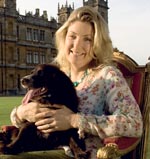Interview: Countess of Carnarvon
The subject most famously associated with the name Carnarvon is the discovery by her great-grandfather of Tutankhamun's tomb. Lady Carnarvon is something on an authority on the fifth earl


There's a dramatic point on the approach to Highclere Castle when a great rampart of finialled towers suddenly comes into view, ranged across the skyline. It's an awe-inspiring sight the top half of the huge, four-square pile that Sir Charles Barry, architect of the Houses of Parliament, built for the 3rd Earl of Carnarvon in 1842. No less awesome is the experience of pulling up into the forecourt and standing in front of two huge and firmly closed front doors. There is time to survey the glorious views north to the Berkshire Downs before I hear approaching foot-steps, and am ushered by a secretary into the Gothic-vaulted hall, and from there through the soaring central saloon to a sitting room at the end of a passage.
When the Countess of Car-narvon breezes into the room five minutes later, any suspicion that the chatelaine of such a place might be intimidatingly grand is at once dispelled. She is relaxed and welcoming, and, over tea, speaks eloquently on a range of topics. We start with the subject most famously associated with the name Carnarvon the discovery by her husband's great-grandfather of Tutankhamun's tomb in 1922 'probably the first world media event'. Lady Carnarvon has become something of an authority on the 5th earl, having spent the past four years delving through the Highclere archives. 'I'd always wanted to write a book, and I realised there was nothing that focused properly on him,' she says of her ongoing project, for which she has trawled through piles of previously undiscovered material and research in museums and libraries to pull the information together. Although not as significant as the cache of Egyptian artefacts her father-in-law found stashed away between two doors at Highclere, her own finds have included a 1911 album of Egyptian photographs at the back of a desk drawer and Capability Brown's plan for the park 'hidden among a pile of stuff in a top room'.
This month, she is publishing a shorter version of her forthcoming book to coincide with the Tutankhamun exhibition opening at the O2 centre in Greenwich on November 15. Carter & Carnarvon is a fascinating compendium of previously unknown photographs and anecdotes in which 'I have attempted to tell, briefly and comprehensively, what is quite a complex story, and also to paint a much broader picture of Carnarvon and Howard Carter than has hitherto been done. I think the earl was an extraordinary man not the spoilt aristocrat and gold-digger of insignificant intelligence generally portrayed. He was a great traveller, loved his books and created one of the finest Egyptian collections. He was also popular, and a real tease.'
Lady Carnarvon regards her lifelong passion for history books as the best training for becoming chatelaine of Highclere. The eldest of six daughters of a London businessman, she went to St Paul's ('I was a shy bookworm') and St Andrews, before becoming a chartered accountant and marrying in 1999 (she has one son and two step-children). She and her husband, the 8th Earl, took over at Highclere in 2003. Since then, she has written a new guidebook, 'which really got me into the stones and bones of the family', and immersed herself in bringing the place alive. Highclere is open to the public, and hosts a range of activities, from weddings to school visits. 'It's all about allowing the place to evolve, and how you convey its history to people today.'
Recent projects have included repainting the saloon gallery and redecorating 11 bedrooms. 'It's quite a masculine house; I have to work in an appropriate style, but also make it homely.' The next project is to redo the Egyptian museum in the basement. Meanwhile, she is developing a new wilderness garden and recreating some of the pre-18th-century landscape with the earl. 'It takes a partnership to get this show on the road, and it's huge fun doing it together. Just sometimes, however, I love to stand on a fumy London street crowded with traffic and shoppers, by way of a contrast.'
Sign up for the Country Life Newsletter
Exquisite houses, the beauty of Nature, and how to get the most from your life, straight to your inbox.
Country Life is unlike any other magazine: the only glossy weekly on the newsstand and the only magazine that has been guest-edited by HRH The King not once, but twice. It is a celebration of modern rural life and all its diverse joys and pleasures — that was first published in Queen Victoria's Diamond Jubilee year. Our eclectic mixture of witty and informative content — from the most up-to-date property news and commentary and a coveted glimpse inside some of the UK's best houses and gardens, to gardening, the arts and interior design, written by experts in their field — still cannot be found in print or online, anywhere else.
-
 Two quick and easy seasonal asparagus recipes to try this Easter Weekend
Two quick and easy seasonal asparagus recipes to try this Easter WeekendAsparagus has royal roots — it was once a favourite of Madame de Pompadour.
By Melanie Johnson
-
 Sip tea and laugh at your neighbours in this seaside Norfolk home with a watchtower
Sip tea and laugh at your neighbours in this seaside Norfolk home with a watchtowerOn Cliff Hill in Gorleston, one home is taller than all the others. It could be yours.
By James Fisher